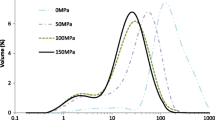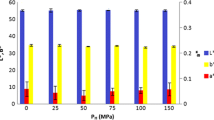Abstract
The rheological properties of a fluid have an important role in process development and optimization. Due to its high concentration, frozen concentrated orange juice (FCOJ) shows viscoelastic behaviour, especially at low temperatures. In this study, high pressure homogenization (HPH) processing (0, 25, 50, 75, 100 and 150 MPa) was used to change the viscoelastic properties of FCOJ. The rheological behaviour of the FCOJ, before and after HPH processing, was evaluated using dynamic frequency sweep procedures. The storage (G′) and loss (G″) moduli were modelled as a function of the oscillatory frequency using the power law. The sample processed at 0 MPa showed G′ > G″. On the other hand, all other samples presented G″ > G′. Both the elastic and viscous behaviours decreased with increasing homogenization pressure. The power law parameters were then modelled as a function of the homogenization pressure using exponential functions. Also, the Cox–Merz rule was verified for all the samples, showing good applicability when a linear mathematical modification was applied. The reduction in the elastic and viscous components was explained by the reduction in particle size and molecular size of the serum constituents. A decrease in viscoelasticity leads to less resistance to flow and therefore to lower energy costs for the FCOJ process. These results are useful to understand the phenomena leading to an industrial application of this technology.






Similar content being viewed by others
Abbreviations
- α :
-
Linear modification of the Cox–Merz rule, Eq. 8 (–)
- β :
-
Linear modification of the Cox–Merz rule, Eq. 9 (–)
- \( \dot{\gamma } \) :
-
Shear rate (s−1)
- η :
-
Viscosity (Pa s)
- η a :
-
Apparent viscosity (Pa s)
- η*:
-
Complex viscosity (Pa s)
- σ :
-
Shear stress (Pa)
- σ 0 :
-
Yield stress (Pa)
- ω :
-
Oscillatory frequency (Hz)
- G′:
-
Storage (elastic) modulus (Pa)
- G″:
-
Loss (viscous) modulus (Pa)
- G*:
-
Complex modulus (Pa)
- k′:
-
Consistency coefficient for the storage modulus power law (Eq. 1) (Pa sn′)
- k″:
-
Consistency coefficient for the loss modulus power law (Eq. 2) (Pa sn″)
- n′:
-
Behaviour coefficient for the storage modulus power law (Eq. 1) (–)
- n″:
-
Behaviour coefficient for the loss modulus power law (Eq. 2) (–)
- P H :
-
Homogenization pressure (MPa)
- tan δ :
-
Loss tangent = G″/G′ (–)
References
Ahmed J, Ramaswamy HS (2006) Viscoelastic and thermal characteristics of vegetable puree-based baby foods. J Food Process Eng 29:219–233
Alvarez MD, Canet W (2013) Dynamic viscoelastic behavior of vegetable-based infant purees. J Texture Stud 44:205–224
Alvarez MD, Fernández C, Canet W (2004) Rheological behaviour of fresh and frozen potato puree in steady and dynamic shear at different temperatures. Eur Food Res Technol 218:544–553
Augusto PED, Vitali AA (2014) Assessing juice quality: advances in the determination of rheological properties of fruit juices and derivatives. In: Falguera V, Ibarz A (eds) Juice processing: quality, safety and value-added opportunities, 1st edn. CRC Press, Boca Raton, pp 83–136
Augusto PED, Falguera V, Cristianini M, Ibarz A (2011) Influence of fibre addition on the rheological proprieties of peach juice. Int J Food Sci Technol 46:1086–1092
Augusto PED, Ibarz A, Cristianini M (2012) Effect of high pressure homogenization (HPH) on the rheological properties of a fruit juice serum model. J Food Eng 111:474–477
Augusto PED, Ibarz A, Cristianini M (2012) Effect of high pressure homogenization (HPH) on the rheological properties of tomato juice: time-dependent and steady-state shear. J Food Eng 111:570–579
Augusto PED, Falguera V, Cristianini M, Ibarz A (2013) Viscoelastic properties of tomato juice: applicability the Cox–Merz rule. Food Bioprocess Technol 6(3):839–843
Augusto PED, Ibarz A, Cristianini M (2013) Effect of high pressure homogenization (HPH) on the rheological properties of tomato juice: viscoelastic properties and the Cox–Merz rule. J Food Eng 114:57–63
Bayod E, Willers EP, Tornberg E (2008) Rheological and structural characterization of tomato paste and its influence on the quality of ketchup. Food Sci Technol 41(7):1289–1300
Bengtsson H, Tornberg E (2011) Physicochemical characterization of fruit and vegetable fiber suspensions. I: effect of homogenization. J Texture Stud 42(4):268–280
Betoret E, Betoret N, Carbonell JV, Fito P (2009) Effects of pressure homogenization on particle size and the functional properties of citrus juices. J Food Eng 92:18–23
Betoret E, Sentadreu E, Betoret N, Fito P (2012) Homogenization pressures applied to citrus juice manufacturing. Functional properties and application. J Food Eng 111(1):28–33
Campos FP, Cristianini M (2007) Inactivation of Saccharomyces cerevisiae and Lactobacillus plantarum in orange juice using ultra high-pressure homogenization. Innov Food Sci Emerg Technol 8:226–229
Canet W, Alvarez MD, Fernández C, Luna P (2005) Comparisons of methods for measuring yield stresses in potato puree: effect of temperature and freezing. J Food Eng 68:143–153
Carbonell JV, Navarro JL, Izquierdo L, Sentandreu E (2013) Influence of high pressure homogenization and pulp reduction on residual pectinmethylesterase activity, cloud stability and acceptability of Lane Late orange juice: a study to obtain high quality orange juice with extended shelf life. J Food Eng 119:696–700
Cerdán-Calero M, Izquierdo L, Sentandreu E (2013) Valencia Late orange juice preserved by pulp reduction and high pressure homogenization: sensory quality and gas chromatography–mass spectrometry analysis of volatiles. Food Sci Technol 51:476–483
Corredig M, Wicker L (2001) Changes in the molecular weight distribution of three commercial pectins after valve homogenization. Food Hydrocoll 15:17–23
Croak S, Corredig M (2006) The role of pectin in orange juice stabilization: effect of pectin methylesterase and pectinase activity on the size of cloud particles. Food Hydrocoll 20:961–965
da Silva JAL, Gonçalves MP, Rao MA (1993) Viscoelastic behaviour of mixtures of locust bean gum and pectin dispersions. J Food Eng 18:211–228
Dogan H, Kokini JL (2007) Rheological properties of foods. In: Heldman DR, Lund DB (eds) Handbook of food engineering, 2nd edn. Taylor and Francis Group, Boca Raton
Dong X, Zhao M, Yang B, Yang X, Shi J, Jiang Y (2011) Effect of high-pressure homogenization on the functional property of peanut protein. J Food Process Eng 34:2191–2204
Falguera V, Ibarz A (2010) A new model to describe flow behaviour of concentrated orange juice. Food Biophys 5:114–119
FAO (Food and Agriculture Organization of United Nations) (2013) http://faostat.fao.org/site/339/default.aspx. Accessed 28 Sept 2013
Floury J, Desrumaux A, Axelos MAV, Legrand J (2002) Degradation of methylcellulose during ultra-high pressure homogenisation. Food Hydrocoll 16:47–53
Gunasekaran S, Ak MM (2000) Dynamic oscillatory shear testing of foods—selected applications. Trends Food Sci Technol 11:115–127
Harte F, Venegas R (2010) A model for viscosity reduction in polysaccharides subjected to high pressure homogenization. J Texture Stud 41:49–61
Ibarz A, Barbosa-Canovas GV (2003) Unit operations in food engineering. CRC Press, Boca Raton
Kin C, Yoo B (2006) Rheological properties of rice starch–xanthan gum mixtures. J Food Eng 72:120–128
Kubo MTK, Augusto PED, Cristianini M (2013) Effect of high pressure homogenization (HPH) on the physical stability of tomato juice. Food Res Int 51:170–179
Lagoueyte N, Paquin P (1998) Effects of microfluidization on the functional properties of xanthan gum. Food Hydrocoll 12(3):365–371
Leite TS, Augusto PED, Cristianini M (2013) Concentrated orange juice viscoelasticity processed by high pressure homogenization technology. In: International nonthermal food processing workshop
Lopez-Sanchez P, Nijsse J, Blonk HCG, Bialek L, Schumm S, Langton M (2011) Effect of mechanical and thermal treatments on the microstructure and rheological properties of carrot, broccoli and tomato dispersions. J Sci Food Agric 91:207–217
Lopez-Sanchez P, Svelander C, Bialek L, Schummm S, Langton M (2011) Rheology and microstructure of carrot and tomato emulsions as a result of high-pressure homogenization conditions. J Food Sci 76(1):E130–E140
Massa A, González C, Maestro A, Labanda J, Ibarz A (2010) Rheological characterization of peach purees. J Texture Stud 41:532–548
Moelants KRN, Cardinaels R, Jolie RP, Verrijssen TAJ, Van Buggenhout S, Zumalacarregui LM, Van Loey AM, Moldenaers P, Hendrickx ME (2013) Relation between particle properties and rheological characteristics of carrot-derived suspensions. Food Bioprocess Technol 6:2870–2883
Oroian M, Amariei S, Escriche I, Gutt G (2013) Rheological aspects of Spanish honey. Food Bioprocess Technol 6:228–241
Pereira EA, Brandão EM, Borges SV, Maia MCA (2008) Influence of concentration on the steady and oscillatory shear behavior of umbu pulp. Rev Bras Eng Agríc Ambient 12(1):87–90
Poliseli-Scopel FH, Hernández-Herrero M, Guamis B, Ferragut V (2012) Comparison of ultra high pressure homogenization and conventional thermal treatments on the microbiological, physical and chemical quality of soymilk. Food Sci Technol 46(1):42–48
Ramamoorthi L, Lee Y, Brewer S (2009) Effect of food matrix and heat treatment on the rheological properties of salmon-based baby food. J Food Eng 95:432–437
Rao MA (2005) Rheological properties of fluid foods. In: Rao MA, Rizvi SSH, Datta AK (eds) Engineering properties of foods, 3rd edn. CRC Press, Boca Raton
Rao MA, Cooley HJ (1992) Rheological behavior of tomato pastes in steady and dynamic shear. J Texture Stud 23:415–425
Sato ACK, Cunha RL (2009) Effect of particle size on rheological properties of jaboticaba pulp. J Food Eng 91:566–570
Sentandreu E, Gurrea MC, Betoret N, Navarro JL (2011) Changes in orange juice characteristics due to homogenization and centrifugation. J Food Eng 105:241–245
Servais C, Jones R, Roberts I (2002) The influence of the particle size distribution on the processing of food. J Food Eng 51:201–208
Silva VM, Sato ACK, Barbosa G, Dacanal G, Ciro-Velásquez HJ, Cunha RL (2010) The effect of homogenisation on the stability of pineapple pulp. Int J Food Sci Technol 45:2127–2133
Steffe JF (1996) Rheological methods in food process engineering, 2nd edn. Freeman Press, East Lansing
Tavares DT, Alcantara MR, Tadini CC, Telis-Romero J (2007) Rheological properties of frozen concentrated orange juice (FCOJ) as a function of concentration and subzero temperatures. Int J Food Prop 10(4):829–839
Tonon RV, Alexandre D, Hubinger MD, Cunha RL (2009) Steady and dynamic shear rheological properties of açai pulp (Euterpe oleraceae Mart.). J Food Eng 92:425–431
Tribst AAL, Augusto PED, Cristianini M (2013) Multi-pass high pressure homogenization of commercial enzymes: effect on the activities of glucose oxidase, neutral protease and amyloglucosidase at different temperatures. Innov Food Sci Emerg Technol 18:83–88
Urbicain MJ, Lozano JE (1997) Thermal and rheological properties of foodstuffs in handbook of food engineering food. CRC Press, Boca Raton
Valencia C, Sánchez MC, Ciruelos A, Latorre A, Franco JM, Gallegos C (2002) Linear viscoelasticity of tomato sauce products: influence of previous tomato paste processing. Eur Food Res Technol 214:394–399
Vélez-Ruíz J (2002) Relevance of rheological properties in food process engineering in engineering and food for the 21st century. CRC Press, Boca Raton
Vitali AA, Rao MA (1984) Flow properties of low-pulp concentrated orange juice: effect of temperature and concentration. J Food Sci 49:882–888
Wang Y, Dong Li D, Wang L, Xuec J (2011) Effects of high pressure homogenization on rheological properties of flaxseed gum. Carbohydr Polym 83:489–494
Wang B, Li D, Wang LJ, Liu YH, Adhikari B (2012) Effect of high-pressure homogenization on microstructure and rheological properties of alkali-treated highamylose maize stach. J Food Eng 113:61–68
Wang T, Sun X, Zhou Z, Chen G (2012) Effects of microfluidization process on physicochemical properties of wheat bran. Food Res Int 48:742–747
Yoo B, Rao MA (1996) Creep and dynamic rheological behavior of tomato concentrates: effect of concentration and finisher screen size. J Texture Stud 27:451–459
Acknowledgments
The authors are grateful to the São Paulo Research Foundation (FAPESP) for funding project no. 2012/15253-9 and for awarding a scholarship to TS Leite (2012/17381-4).
Author information
Authors and Affiliations
Corresponding author
Rights and permissions
About this article
Cite this article
Leite, T.S., Augusto, P.E.D. & Cristianini, M. Processing Frozen Concentrated Orange Juice (FCOJ) by High Pressure Homogenization (HPH) Technology: Changes in the Viscoelastic Properties. Food Eng Rev 7, 231–240 (2015). https://doi.org/10.1007/s12393-014-9082-y
Received:
Accepted:
Published:
Issue Date:
DOI: https://doi.org/10.1007/s12393-014-9082-y




